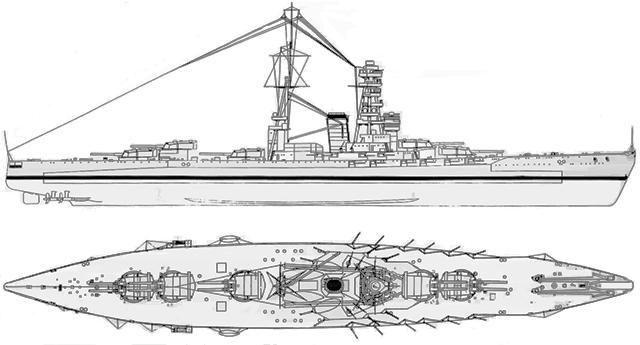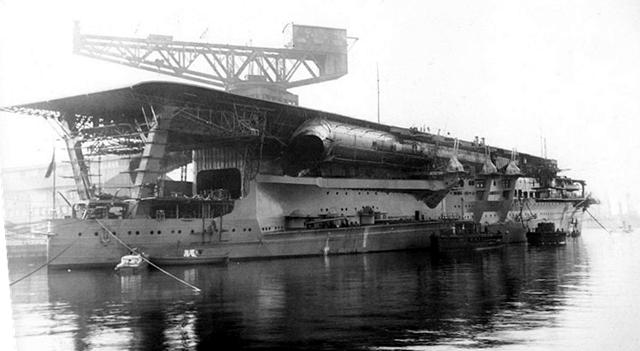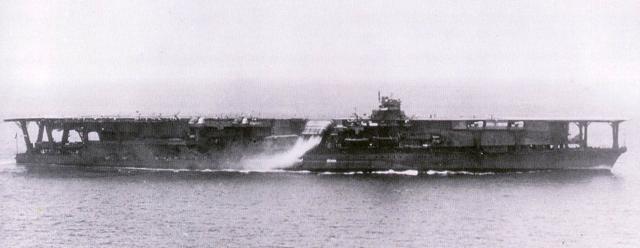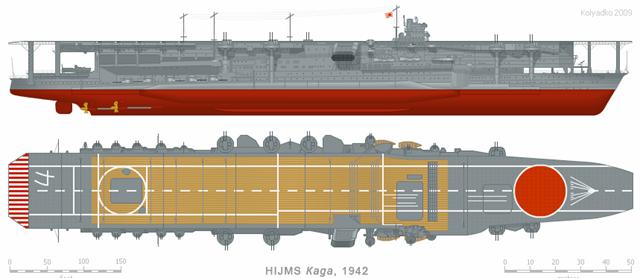March 15, 2011
Genesis Of An Aircraft Carrier
In 1905, the Imperial Japanese Navy (IJN) showed the world that is was at least the equal of any Western navy by its complete domination at the Battle of Tsushima. In this climax to the Russo-Japanese War, the Japanese battle fleet, commanded by Admiral Togo, annihilated the Russian Second Pacific Squadron at the cost of three small torpedo boats.
By 1906 though, the Japanese fleet was made obsolete by the appearance of HMS Dreadnought in the British Royal Navy. Realizing that evolving technology had laid their fleet to waste (and terrified by that fact), the IJN made plans for a new and improved fleet of ships. Called the "Eight-Eight Fleet", it was to be based around eight new Dreadnought-style battleships and eight cruisers. Designed to be capable of going toe-to-toe with the US Navy, even at this early date thought to be Japan's most likely foe, this battleline was considered the only way the nation of Japan could be made safe. Though the country had been practically bankrupted by its war with the Russians, the first batch of ships was approved in 1911.
Events on the other side of the world again worked against the IJN's plans. While Japan had sided with the Allies in World War I, for all intents and purposes she had little to do with the European theater of war. Instead, she had little spats with far-flung German possessions in the Pacific. Meanwhile, the war in the Atlantic led to massive improvements in naval technologies for the combatants there. Suddenly, the IJN again found themselves with seemingly obsolescent ships while their rivals had honed their fleets against the whetstone of war.
The decision was made to scrap the first Eight-Eight fleet plans and start a second. This second fleet was to be built around a nucleus of the newest vessels of the first, two completed battleships of the Nagato-class, two Tosa-class battleships that were in the process of being built, and four Amagi-class battlecruisers that were in various stages of construction. They were to be joined by four battleships of an unnamed class that was to carry 18" guns, and four "fast battleships" to accompany the battlecruisers.
The Amagi-class was to tip the scales at over 41000 tons, be capable of 30kts, and carry ten 16" guns on a hull some 826 feet long. As with all battlecruisers, the Amagis were not particularly well-armored; they were designed to be able to outgun anything they could outrun (cruisers of all sizes and destroyers), and outrun anything that outgunned them (battleships, mostly). While in retrospect it's clear that the battlecruiser concept was deeply flawed, the thinking of the time was that speed, not armor plating, would be a battlecruiser's best defense.

In 1922, the IJN's plans again had to be scrapped when Japan became a signatory to the Washington Naval Treaty. This attempt to curtail the growing naval arms race ongoing between Britain, America, Japan, France and Italy placed an upper limit on the size of any ship built of 35000 tons. All work on the four battlecruisers and two battleships came to a halt, in preparation for scrapping. With the stroke of a pen, both the Amagi-class and the Tosa-class, like the British N3 and G3 designs, had been invalidated.
Or almost so. The Treaty placed an upper limit on the size of aircraft carriers of 27000 tons. However, a provision of the treaty, insisted upon by both the Americans and the Japanese, allowed for the conversion of two ships of a maximum weight of 33000 tons each to aircraft carriers. The US Navy selected two Lexington-class battlecruisers for conversion. The IJN chose two of their Amagis, the namesake of the class and the Akagi, to be subjects for their conversions. The remaining battlecruisers were broken up and scrapped.
And then nature stepped in.
On September 1st, 1923, Japan was struck by the Great Kanto Earthquake. This magnitude 7.9 quake was centered just off Tokyo Bay and lasted for somewhere between four and ten minutes. The city of Tokyo was devastated and much of the Kanto plain suffered horrible damage. Some 100000 people lost their lives, and 1.9 million were rendered homeless. The port city of Yokohama was leveled both by the earthquake and by the fires it caused.
Also severely damaged was the Yokosuka Naval Armory, one of Japan's largest shipyards and the site of the Amagi's conversion. The incomplete hull suffered massive shock damage from the earthquake, to the point where repairs were considered infeasible. The Amagi was struck from the navy list shortly thereafter and scrapped in 1924. This allowed the IJN designers to select another ship for conversion. However, the other two battlecruiser hulls were already being scrapped, so they couldn't be used (and even before scrapping, neither were particularly far along in the construction process).
After a short evaluation process, it was decided to take one of the Tosa-class battleships and reorder it as an aircraft carrier. The second of the class, Kaga, was duly selected as being the better candidate of the two and taken into the yards for conversion. The work was slowed by many factors, not least of which was Japan's economic straits, and took nearly five years to complete. She was released for sea trials in 1928, some seven years after she was first floated as a battleship.

As built, she came in at just under the 33000 ton limit set by the Washington Naval Treaty with a length of 782 feet, only some 20 feet longer than her original design as a battleship called for. She carried ten 8" guns, as defense against enemy cruisers, and her original powerplant was able to propel her at 27.5kts.

Like British carriers of the time, the Kaga had three flying-off decks. The main flight deck was just over 560 feet long. The middle deck was only 50 feet long and of questionable value even when first built; even the small, lightweight planes of the time could only barely use it, and only when completely unladen with ordinance. The lowest deck measured 180 feet.

She had two main hangar decks which opened directly onto the lowest two flying-off decks and a third, auxiliary hangar, allowing for a total of 60 aircraft as built. Two lifts serviced the main flight deck. In partnership with the Akagi, the Kaga helped create the IJN's aerial operation doctrines, but was found to have some serious limitations. Her unique funnel arrangement, trunked far aft and down, was found to create serious problems for landing fliers. Part of the reason for this was her relatively slow speed; unlike the Akagi, she could not "outrun her gases." With the increase in size and power of newer aircraft making her less and less useful, it was decided to bring the Kaga in for another remodel in 1934.

During this reconstruction, her lower two flying-off decks were plated in and extended nearly to her bows, in effect elongating the two main hangar decks. This allowed the Kaga to ship 90 aircraft (72 active, 18 in knocked-down condition as spares). Her machinery was completely replaced with more powerful engines, but an increase in displacement to 38000 tons roughly balanced out the increase in power; her top speed increased by just over a knot. Perhaps most importantly, her funnels were modified to match that of Akagi: a short downward-angled stack near amidships. This much improved the flight characteristics for her aircraft, as did the full-length main flight deck. A small island was added to the starboard side of the flight deck at this time as well.

It was in this configuration that she went to war, first in the China conflict, then as part of Kido Butai as the war spread to the entire Pacific. She was part of the attack at Pearl Harbor, supported the invasion of Rabaul, launched air strikes against Darwin, Australia, and was one of four carriers tasked for the attack of Midway. There she was hit by four bombs by SBD Dauntless dive bombers, three of which exploded in her hangar decks. These caused intense fires that swept the length of the ship, causing secondary explosions amongst the planes being fueled and loaded on the hangar decks, and eventually caused her to be abandoned in the afternoon of June 4th, 1942, and scuttled that evening, never to be seen again... until 57 years later.
Late in 1999, explorers from the Nauticos company discovered some of Kaga's wreckage, located nearly 17000 feet below the surface of the ocean.
Comments are disabled.
Post is locked.
By 1906 though, the Japanese fleet was made obsolete by the appearance of HMS Dreadnought in the British Royal Navy. Realizing that evolving technology had laid their fleet to waste (and terrified by that fact), the IJN made plans for a new and improved fleet of ships. Called the "Eight-Eight Fleet", it was to be based around eight new Dreadnought-style battleships and eight cruisers. Designed to be capable of going toe-to-toe with the US Navy, even at this early date thought to be Japan's most likely foe, this battleline was considered the only way the nation of Japan could be made safe. Though the country had been practically bankrupted by its war with the Russians, the first batch of ships was approved in 1911.
Events on the other side of the world again worked against the IJN's plans. While Japan had sided with the Allies in World War I, for all intents and purposes she had little to do with the European theater of war. Instead, she had little spats with far-flung German possessions in the Pacific. Meanwhile, the war in the Atlantic led to massive improvements in naval technologies for the combatants there. Suddenly, the IJN again found themselves with seemingly obsolescent ships while their rivals had honed their fleets against the whetstone of war.
The decision was made to scrap the first Eight-Eight fleet plans and start a second. This second fleet was to be built around a nucleus of the newest vessels of the first, two completed battleships of the Nagato-class, two Tosa-class battleships that were in the process of being built, and four Amagi-class battlecruisers that were in various stages of construction. They were to be joined by four battleships of an unnamed class that was to carry 18" guns, and four "fast battleships" to accompany the battlecruisers.
The Amagi-class was to tip the scales at over 41000 tons, be capable of 30kts, and carry ten 16" guns on a hull some 826 feet long. As with all battlecruisers, the Amagis were not particularly well-armored; they were designed to be able to outgun anything they could outrun (cruisers of all sizes and destroyers), and outrun anything that outgunned them (battleships, mostly). While in retrospect it's clear that the battlecruiser concept was deeply flawed, the thinking of the time was that speed, not armor plating, would be a battlecruiser's best defense.

Tosa-class battleship
The Amagi's heavier teammate on the battleline, the Tosa-class battleship, was paradoxically smaller than the battlecruiser in most ways. Coming in at just under 40000 tons and 760 feet long, they were to cruise at just over 26 knots. Armed with ten 16" rifles of the same type carried by the battlecruisers, their secondary battery of twenty 5" guns compared favorably to that carried by the Amagi. As with most battleships, the Tosa's armor was to be its strong point. In short, the Tosas were to slug it out with opponents while the Amagis danced in and out of the battle.In 1922, the IJN's plans again had to be scrapped when Japan became a signatory to the Washington Naval Treaty. This attempt to curtail the growing naval arms race ongoing between Britain, America, Japan, France and Italy placed an upper limit on the size of any ship built of 35000 tons. All work on the four battlecruisers and two battleships came to a halt, in preparation for scrapping. With the stroke of a pen, both the Amagi-class and the Tosa-class, like the British N3 and G3 designs, had been invalidated.
Or almost so. The Treaty placed an upper limit on the size of aircraft carriers of 27000 tons. However, a provision of the treaty, insisted upon by both the Americans and the Japanese, allowed for the conversion of two ships of a maximum weight of 33000 tons each to aircraft carriers. The US Navy selected two Lexington-class battlecruisers for conversion. The IJN chose two of their Amagis, the namesake of the class and the Akagi, to be subjects for their conversions. The remaining battlecruisers were broken up and scrapped.
And then nature stepped in.
On September 1st, 1923, Japan was struck by the Great Kanto Earthquake. This magnitude 7.9 quake was centered just off Tokyo Bay and lasted for somewhere between four and ten minutes. The city of Tokyo was devastated and much of the Kanto plain suffered horrible damage. Some 100000 people lost their lives, and 1.9 million were rendered homeless. The port city of Yokohama was leveled both by the earthquake and by the fires it caused.
Also severely damaged was the Yokosuka Naval Armory, one of Japan's largest shipyards and the site of the Amagi's conversion. The incomplete hull suffered massive shock damage from the earthquake, to the point where repairs were considered infeasible. The Amagi was struck from the navy list shortly thereafter and scrapped in 1924. This allowed the IJN designers to select another ship for conversion. However, the other two battlecruiser hulls were already being scrapped, so they couldn't be used (and even before scrapping, neither were particularly far along in the construction process).
After a short evaluation process, it was decided to take one of the Tosa-class battleships and reorder it as an aircraft carrier. The second of the class, Kaga, was duly selected as being the better candidate of the two and taken into the yards for conversion. The work was slowed by many factors, not least of which was Japan's economic straits, and took nearly five years to complete. She was released for sea trials in 1928, some seven years after she was first floated as a battleship.

As built, she came in at just under the 33000 ton limit set by the Washington Naval Treaty with a length of 782 feet, only some 20 feet longer than her original design as a battleship called for. She carried ten 8" guns, as defense against enemy cruisers, and her original powerplant was able to propel her at 27.5kts.

Like British carriers of the time, the Kaga had three flying-off decks. The main flight deck was just over 560 feet long. The middle deck was only 50 feet long and of questionable value even when first built; even the small, lightweight planes of the time could only barely use it, and only when completely unladen with ordinance. The lowest deck measured 180 feet.

She had two main hangar decks which opened directly onto the lowest two flying-off decks and a third, auxiliary hangar, allowing for a total of 60 aircraft as built. Two lifts serviced the main flight deck. In partnership with the Akagi, the Kaga helped create the IJN's aerial operation doctrines, but was found to have some serious limitations. Her unique funnel arrangement, trunked far aft and down, was found to create serious problems for landing fliers. Part of the reason for this was her relatively slow speed; unlike the Akagi, she could not "outrun her gases." With the increase in size and power of newer aircraft making her less and less useful, it was decided to bring the Kaga in for another remodel in 1934.

During this reconstruction, her lower two flying-off decks were plated in and extended nearly to her bows, in effect elongating the two main hangar decks. This allowed the Kaga to ship 90 aircraft (72 active, 18 in knocked-down condition as spares). Her machinery was completely replaced with more powerful engines, but an increase in displacement to 38000 tons roughly balanced out the increase in power; her top speed increased by just over a knot. Perhaps most importantly, her funnels were modified to match that of Akagi: a short downward-angled stack near amidships. This much improved the flight characteristics for her aircraft, as did the full-length main flight deck. A small island was added to the starboard side of the flight deck at this time as well.

It was in this configuration that she went to war, first in the China conflict, then as part of Kido Butai as the war spread to the entire Pacific. She was part of the attack at Pearl Harbor, supported the invasion of Rabaul, launched air strikes against Darwin, Australia, and was one of four carriers tasked for the attack of Midway. There she was hit by four bombs by SBD Dauntless dive bombers, three of which exploded in her hangar decks. These caused intense fires that swept the length of the ship, causing secondary explosions amongst the planes being fueled and loaded on the hangar decks, and eventually caused her to be abandoned in the afternoon of June 4th, 1942, and scuttled that evening, never to be seen again... until 57 years later.
Late in 1999, explorers from the Nauticos company discovered some of Kaga's wreckage, located nearly 17000 feet below the surface of the ocean.
Posted by: Wonderduck at
12:40 AM
| Comments (2)
| Add Comment
Post contains 1528 words, total size 12 kb.
Posted by: The Old Man at March 15, 2011 10:58 AM (TcNy+)
2
Thanks for the great article! And since it was an article that I "won" in one of your ship identification contests, does this mean it's time for another? 
Posted by: Siergen at March 15, 2011 04:54 PM (Gqqsw)
28kb generated in CPU 0.0197, elapsed 0.0814 seconds.
46 queries taking 0.0744 seconds, 163 records returned.
Powered by Minx 1.1.6c-pink.
46 queries taking 0.0744 seconds, 163 records returned.
Powered by Minx 1.1.6c-pink.









